This vegan pesto recipe is a tasty combination of fresh greens, herbs, and almonds. While pesto tends to have dairy in it in the form of Parmesan cheese, this one doesn't have any. As a result, it is a perfect vegan option to serve your family and friends.
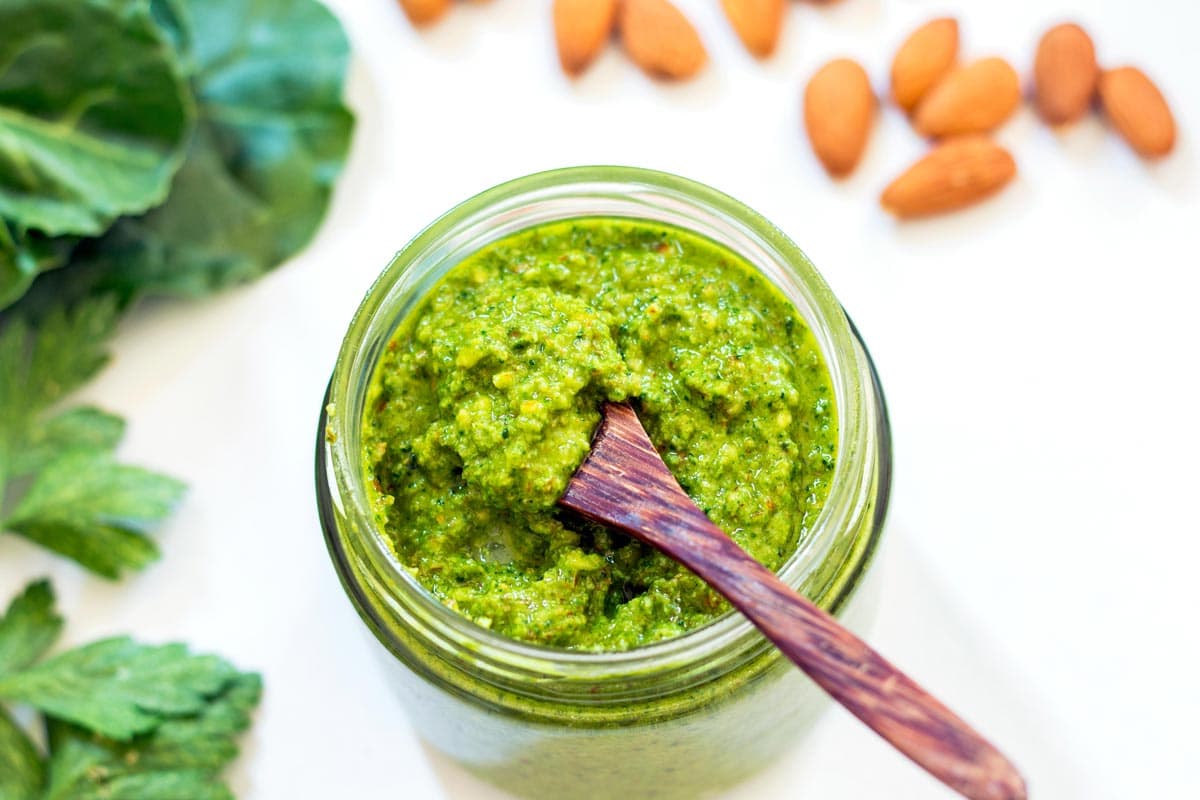
What is this Vegan Pesto Made of?
This vegan pesto has a short prep time (the total time should only take 10 minutes or so) and comprises of your choice of fresh greens and herbs, along with some flavourings like garlic and lime. This is an excellent recipe for when you have a small amount of greens or some leftover herbs on hand. You can really use almost anything soft and leafy.
For greens, Swiss chard, spinach, kale, and carrot greens work wonderfully well. Swiss chard and kale are particularly great if you grow them in a garden. They keep producing all season long under the right conditions. In the case of these hardier greens, however, you will want to be sure to remove the stems and simply use the leafy bits. Don't throw them away, though, as they are great for simmering in broth with chicken or turkey bones and vegetable scraps. You could also quick pickle them in a jar.
For herbs, softer herbs like parsley, cilantro, and fresh basil leaves are ideal as they are exceptionally fragrant and soft-textured. You should avoid using woody herbs like rosemary or sage that have very strong tastes. They might overpower your sauce and may not blend in as well.
The nuts used in this pesto are almonds because they are cheaper than pine nuts. They add some robustness and crunch to this bright green pesto.
For liquids, extra virgin olive oil is traditional and helps the pesto become nice and saucy. The lime juice helps keep the greens bright and pretty, in addition to adding some acidity. You could substitute it with lemon juice if you have it, though. Lemon juice provides a tangier flavour than lime.

No Parmesan Cheese?
This pesto sauce may not have any Parmesan cheese in it, but that does not mean it is devoid of flavour. It includes a garlic clove, lime juice, and raw almonds to give it taste and body. Some people might like to use nutritional yeast for a cheesy taste in their vegan pesto recipes, but it really isn't necessary.
This is a fresher tasting pesto that will be great for you to toss with hot cooked pasta, add to the base of a pizza, or use as a marinade for grilling meat or vegetables.
Making this Vegan Pesto Recipe
This simple vegan pesto sauce is so easy to make. As long as you have a food processor, you will be able to make it on a whim, even at the last minute before you intend to use it. There are a few things to keep in mind, though.
First, you should blend the greens and herbs with the seasonings and lime juice first, and start running the food processor. While the food processor is running, the olive oil gets drizzled in until a smooth paste forms. The reason you don't want to add the oil to the bowl with the greens and herbs at the start is that it won't emulsify correctly. The recipe has the almonds added at the end so that they retain some of their texture and don't become over-blended. We don't want pesto flavored nut butter here.
Can I Substitute Other Ingredients for Almonds?
Yes, you can! While almonds offer tremendous taste and texture to this pesto, not everyone can have them. Luckily other options, like pine nuts, should work just as well.
The most classic option for basil pesto recipes is pine nuts, which are delicious but somewhat expensive. Pine nuts tend to take a long time to produce, which is why they have a higher cost than other nuts. If you would like a cheaper option, walnuts are another great choice for their savouriness and crunch.
If you would like a completely nut-free vegan pesto, you could use sunflower seeds, pumpkin seeds or hemp hearts in place of pine nuts or almonds. Sunflower seeds, in particular, are great because they have a high oil content in them that blends really nicely into the sauce.
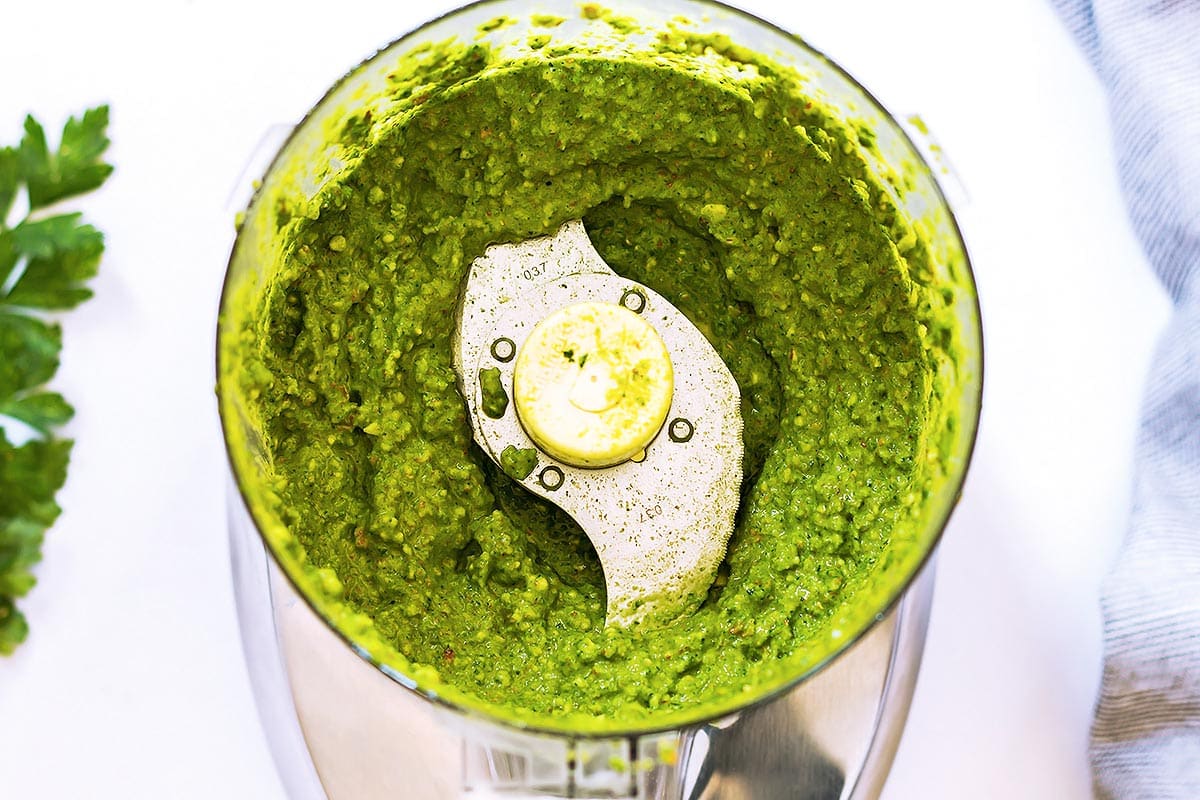
Can I Make Pesto Without a Food Processor?
There are a few options if you need to make this vegan pesto recipe without a processor. The first one would be to simply make it in a high-powered blender. In this case, you will want to watch the pesto a little more closely in order to ensure that the almonds don't become too fine, but it should work just as well.
If you have an immersion blender, you could try that, too. In this case, use the immersion blender to pulse the ingredients in the first step, adding the oil a little at a time. When it comes time to add the nuts, you may want to finely chop them by hand, as its blades may not be sufficient to break down whole almonds. This really depends on the quality of the immersion blender you have.
You can also use a mortar and pestle, which actually is the traditional Italian way of making pesto. Start by first crushing the garlic with the salt. The salt will help with reducing it into a paste. Then, you can add the herbs (fresh basil, parsley, or cilantro) and greens a little at a time and pound with the pestle until they start to break down. Next, throw in the nuts and crush until fine. Finally, you can use the pestle when you add in the olive oil and lime juice so that it becomes a pesto-like mixture. This process takes a little more time but can give you more control over the texture.
The final option would be just to make the entire pesto by hand. In this case, finely chop the greens and fresh basil (or other fresh herbs), and place them in a sealable bag with the remaining ingredients including the olive oil. Then, roll a rolling pin over the bag to break the pesto ingredients down until very fine and saucy.

Uses for Vegan Pesto
This vegan pesto is saucy and thick, perfect for coating pasta noodles like penne, farfalle, or fusilli. This is perhaps the most classic way of enjoying pesto and works well with homemade whole wheat pasta or gluten free noodles as well. With a pasta machine you could easily make homemade gluten free noodles too.
Another way to use this pesto is in a compound butter. For this, simply blend softened butter with enough pesto to colour it. You can then wrap the butter mixture in plastic wrap and shape it as a log to refrigerate. This butter can be used to melt over hot cooked vegetables like grilled asparagus or blanched beans.
Another option would be to add a dollop of it to your favourite grain bowl or power bowl for the sauce or even to stir into soups. This could be very delicious in minestrone soups or bean-based soups.
I also like using pesto to flavor dips for appetizers. Stir some pesto into plain hummus or mix it onto mashed avocado for a pesto guacamole and dip anything from veggie sticks to crackers.
Random Questions
Vegan pesto typically consists of fresh greens, herbs, nuts, garlic, lime or lemon juice, and olive oil. Almonds are commonly used instead of traditional pine nuts, and nutritional yeast can be added for a cheesy flavor.
If you need a pesto substitute, you can try a blend of fresh herbs, nuts, olive oil, and garlic. For a nut-free version, sunflower seeds or pumpkin seeds can be used. Additionally, a combination of basil, spinach, and kale can mimic the flavors of traditional pesto.
Dairy-free pesto excludes ingredients like Parmesan cheese and may use nutritional yeast for a similar cheesy flavor. It typically contains fresh greens, herbs, nuts, garlic, lime or lemon juice, and olive oil for a rich and flavorful sauce.
Vegetarian pesto typically excludes meat and fish-based ingredients. It uses fresh greens, herbs, nuts, garlic, and olive oil as the base, offering a vibrant and flavorful option that aligns with vegetarian dietary preferences.
More Pesto Recipes You'll Love:
Recipe
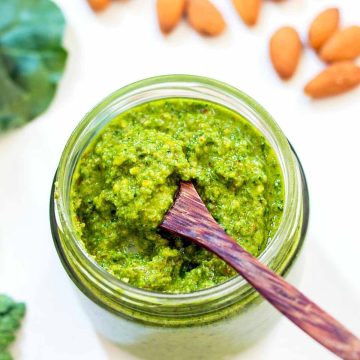
Vegan Pesto Recipe
Ingredients
- 1-½ cup green leaves (kale, spinach, Swiss chard, carrot greens) torn, hard stems removed
- ½ cup herbs (parsley, cilantro, basil)
- ¼ teaspoon sea salt
- 1 clove garlic
- 1 large lime juiced
- ½ cup oil olive or avocado
- ⅓ cup raw almonds other nuts/seeds can be substituted
Instructions
- Place greens (hard stems removed), herbs, salt, garlic and lime juice in a food processor bowl.
- Turn on the food processor and slowly pour in the oil while machine is running.
- Turn off the food processor and open the lid. Scrape down the sides with a spatula.
- Add the almonds (or other nuts) and close the lid again. Pulse the food processor until the nuts are coarsely chopped and incorporated into the pesto.
- Store pesto refrigerated in an airtight container. Pour a touch of extra oil over the top to cover the pesto. Use within a week.
Notes
Pin Pesto Recipe for later?
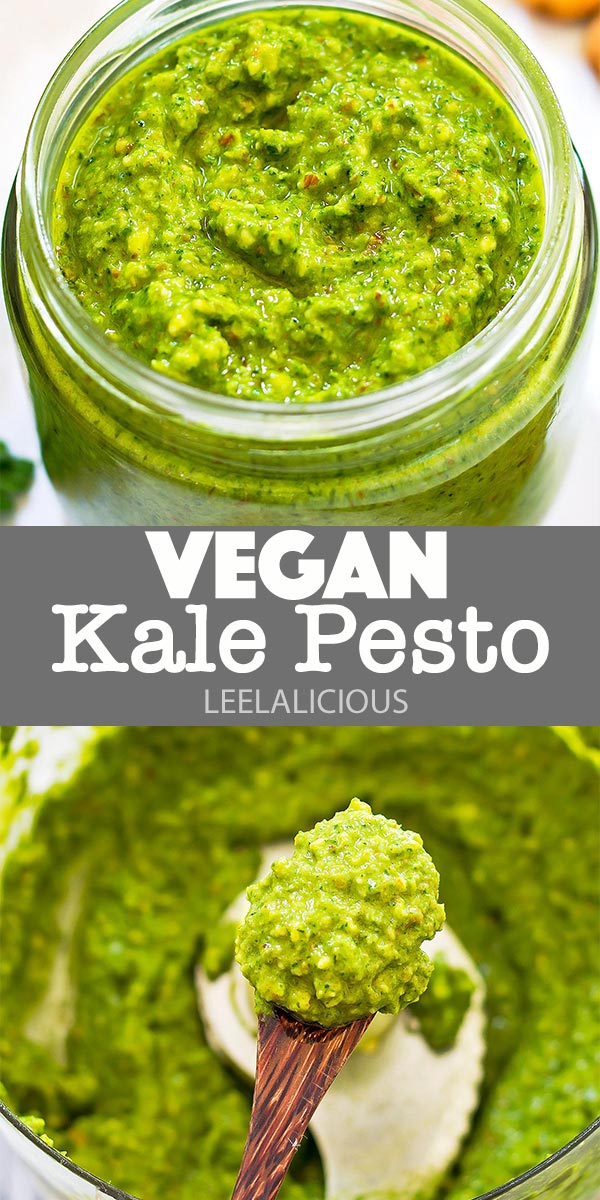


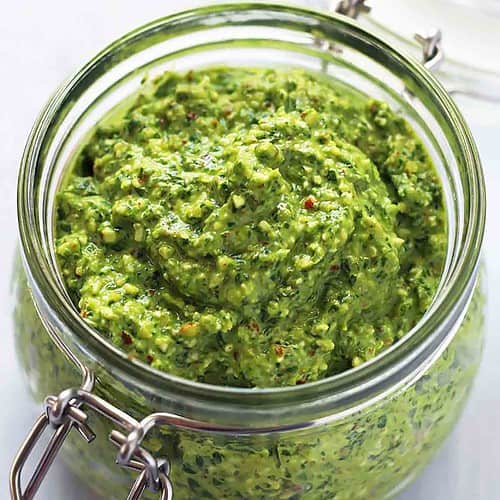
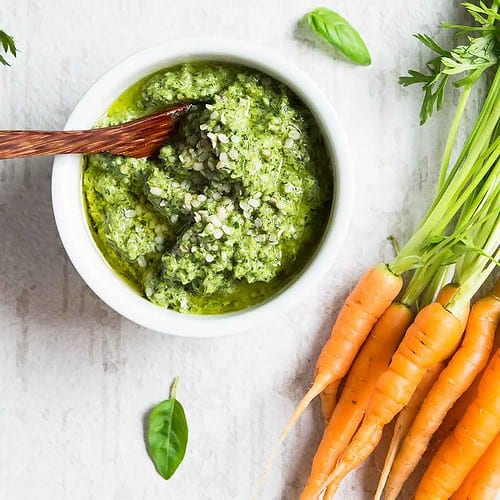
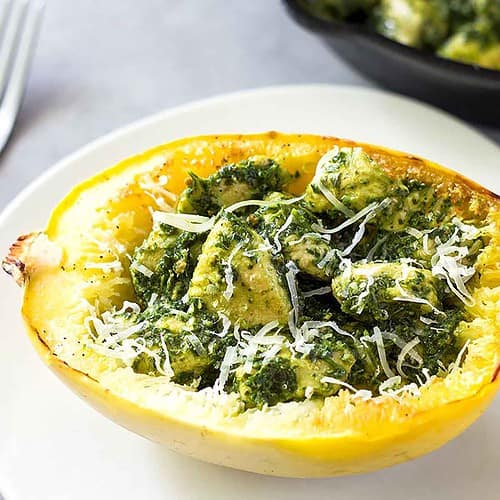
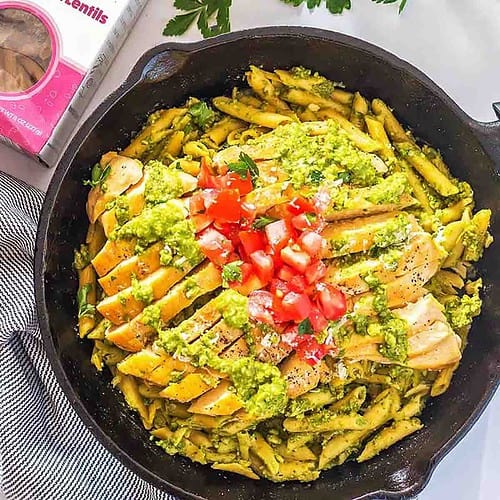
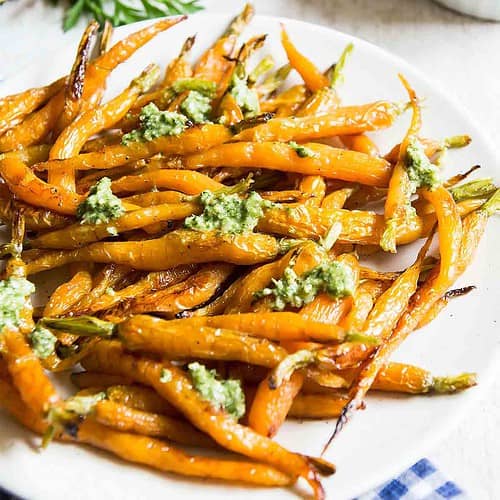
Leave a Reply